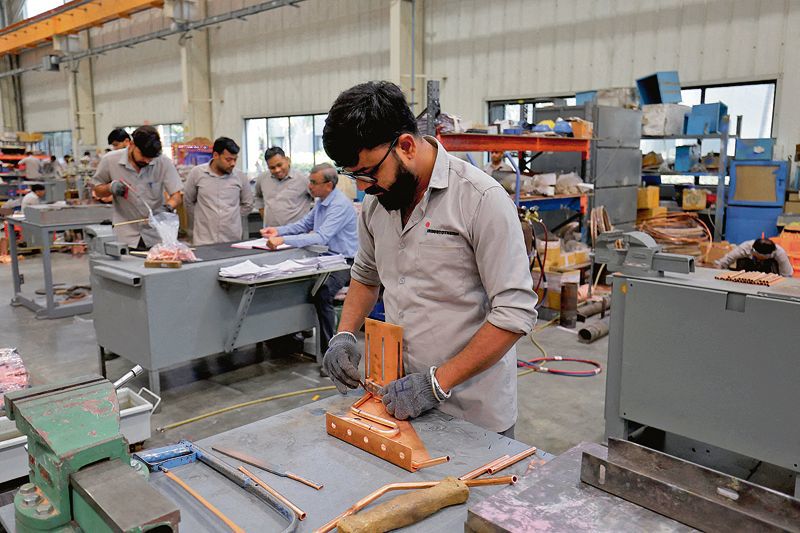
Potential: There is a need to ensure that there is skilled labour to use the job opportunities thrown up by new manufacturing projects. Reuters
Sushma Ramachandran
Senior Financial Journalist
THE management of the economy is bound to be at the top of the new government’s agenda. ‘It’s the economy, stupid’ is a catchline made famous by Bill Clinton’s 1992 election campaign, and it is still relevant. The Indian economy may be in relatively good shape, with GDP growth outpacing all others globally, but this is still a developing country with sizable segments in the poor and underprivileged categories. Pulling them out of poverty and reducing the inequality that has virtually created two Indias on a single subcontinent will have to be the focus of the new set of policymakers. The concept of a viksit or developed Bharat is unexceptionable, but the elements of society that are lagging behind will have to catch up before the country can truly reach the status of a developed nation.
To reduce the inequalities that exist between the burgeoning urban middle class and the less privileged masses in rural areas, the biggest task will be to move jobs away from agriculture and towards the more vibrant industrial and services sectors. Right now, 45 per cent of jobs are dependent on agriculture, a sector that comprises only 15 per cent of the GDP. The NDA (2019-24) government had taken an initiative on this front, infusing massive public capital expenditure into infrastructure development over the past few years. But this laudable policy measure has not created as many jobs as needed, given the enormity of the country’s working-age population.
There are differing estimates of actual unemployment in the country. The latest Periodic Labour Force Survey shows that the unemployment rate was 3.1 per cent in 2023, the lowest in three years. On the other hand, a private sector think tank, Centre for Monitoring Indian Economy, puts the unemployment rate for 2023-24 at 8 per cent.
Despite the differing data, the underlying conclusion is that more jobs need to be created rapidly. The drive to set up the much-needed infrastructure through a big capex thrust now needs to be accompanied by much more investment from the private sector, both from domestic and foreign sources. This will have to be aided by improving the ease of doing business. Though the current regime made some headway in this direction, bureaucracy and procedural complexities still abound.
Officials involved in this exercise at the Central level say the problem is with the states. To some extent, this is true. It can be seen from the fact that some states, especially in southern India, attract far more foreign direct investment than others. For instance, tech giant Apple is clearly only interested in setting up projects in Tamil Nadu, Karnataka and Andhra Pradesh. Gujarat is another state that has for long attracted investors and is now catching the attention of semi-conductor firms considering massive investments in this high-tech area.
The uneven scenario in individual states is likely to presage a pivot in the reform process from the Central to the state level. The brief economic statement that replaced the annual survey in this year’s Interim Budget talks of the states’ role in making future economic reforms more ‘purposeful and fruitful’. It goes on to highlight the need for improving governance at the district, block and village levels, making them both citizen- and business-friendly.
One must not forget that the Budget provided the first ever interest-free loan of Rs 75,000 crore for states to frame growth- and development-oriented reforms. This is clearly a bid to lure less investment-oriented states to carry out business-friendly reforms.
But it is not enough to attract investments. There is a need to ensure that there is skilled labour to use the job opportunities thrown up by new manufacturing projects. Providing an education that makes the much-talked-about youth demographic more employable is the need of the hour. This must start at the school level and continue through vocational institutions that impart relevant technical skills. An economy known for its expertise in software and computers should be able to provide a high-quality education in ancillary areas. Excellence in learning must go beyond the renowned engineering and science institutions.
In evolving new education policies, it would be useful to involve the industry closely. This could help improve the employability of those seeking to enter the manufacturing sector. At the same time, the private sector needs to reduce the share of contract jobs so that there is greater security of employment. The long-term nature of government jobs is the reason they are considered the goal of millions in this country. It has created the myth that only government jobs are worthwhile. Some political parties have unwisely promoted this theme during election campaigns by promising government jobs as sops for voters.
On the contrary, entrepreneurship should be given greater encouragement, for this truly yields sizable returns, especially in high-tech areas. Startups have been adopted enthusiastically by the youth in this country. In fact, India now nurtures one of the biggest global ecosystems for unicorns and decacorns. Even micro and tiny enterprises are being given support through Internet marketing platforms. This is the future, and employment opportunities need to be viewed through a different prism now rather than as the ‘pukki naukri’ (secure jobs) of old.
The long-term agenda for any new government will thus have to be holistic, as GDP growth already reached an encouraging 8.2 per cent in 2023-24. Sustaining this growth will mean raising private investment currently lagging behind public capex. Foreign direct investment flows will also need a boost, as the latest data shows a decline in the last fiscal. This could reflect the challenges of external headwinds, especially geopolitical tensions. Raising growth in rural areas will also need to be kept in focus, though the forecast of a normal monsoon this year means agricultural output is set to be higher than the 1.4 per cent of last year. Rural consumption is already picking up and could soon reach a broad-based recovery. The goal of more equitable growth is thus achievable but will need a great deal of hard work.
Join Whatsapp Channel of The Tribune for latest updates.




























